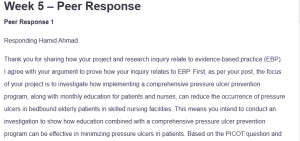Week 5 – Peer Response
Peer Response 1
Responding Hamid Ahmad.
Thank you for sharing how your project and research inquiry relate to evidence-based practice (EBP). I agree with your argument to prove how your inquiry relates to EBP. First, as per your post, the focus of your project is to investigate how implementing a comprehensive pressure ulcer prevention program, along with monthly education for patients and nurses, can reduce the occurrence of pressure ulcers in bedbound elderly patients in skilled nursing facilities. This means you intend to conduct an investigation to show how education combined with a comprehensive pressure ulcer prevention program can be effective in minimizing pressure ulcers in patients. Based on the PICOT question and the objective you have stated for your project, it is clear that you will further improve the current state of evidence in pressure ulcer prevention using research to improve practice. You have further noted that the expected outcomes from your research inquiry include reducing the incidence of pressure ulcers among the elderly population in nursing facilities. This aligns with the focus on EBP as you aim to solve a clinical problem, which in this case is pressure ulcers in elderly patients, using the best evidence from research. It can be said that your inquiry relates with EBP as EBP is a problem-solving approach to clinical practice that involves the use of the current and valid research evidence in medical decision-making and clinical practice (Ratish, 2019).
Additionally, it cannot be termed as quality research evidence unless it has been evaluated. The utilization of EBP in clinical and nursing practice is to provide high-quality care and achieve improved patient outcomes with reduced costs of care (Sharplin et al., 2019). In your case, focusing on comparing the number of new pressure ulcer cases before and after the intervention is a good evaluation of the success of the project and determination of the quality of evidence. Therefore, if the evidence developed by your project is of high quality, you will see a decrease in the number of new pressure ulcers.
References
Ratish, S. (2019). Evidence-Based Practice-A Key to Quality Patient Care. International Journal of Nursing Education and Research, 7(4), 638. https://doi.org/10.5958/2454-2660.2019.00144.3
Sharplin, G., Adelson, P., Kennedy, K., Williams, N., Hewlett, R., Wood, J., Bonner, R., Dabars, E., & Eckert, M. (2019). Establishing and Sustaining a Culture of Evidence-Based Practice: An Evaluation of Barriers and Facilitators to Implementing the Best Practice Spotlight Organization Program in the Australian Healthcare Context. Healthcare 2019, Vol. 7, Page 142, 7(4), 142. https://doi.org/10.3390/HEALTHCARE7040142
ORDER A PLAGIARISM-FREE PAPER HERE
We’ll write everything from scratch
Question
PEER RESPONSE 1:
BY: Hamid Ahmad
My research inquiry is directly tied to evidence-based practice (EBP) because it focuses on using proven strategies to improve patient outcomes. The PICOT question investigates how implementing a comprehensive pressure ulcer prevention program, along with monthly education for patients and nurses, can reduce the occurrence of pressure ulcers in bedbound elderly patients in skilled nursing facilities. EBP involves integrating the best available evidence, clinical expertise, and patient preferences to improve care (den Hertog & Niessen, 2021). The prevention program in my inquiry is based on research that has shown the effectiveness of education and prevention techniques in minimizing pressure ulcers.
The expected practice improvement outcomes from my inquiry include reducing the incidence of pressure ulcers among the elderly population in nursing facilities. By offering monthly education sessions for both patients and nurses, I aim to increase awareness, promote better care practices, and ensure timely intervention. This proactive approach should lead to fewer new cases of pressure ulcers, thereby improving patient comfort (Alhammadi & Ogale, 2020).

Week 5 – Peer Response
To evaluate the success of my capstone project, I will compare the number of new pressure ulcer cases before and after the intervention. This will involve tracking the incidence of pressure ulcers over a four-month period (Alhammadi & Ogale, 2020). I will also assess patient and nurse feedback to determine whether the education component has improved their knowledge and care practices. Success will be measured by a decrease in the number of new pressure ulcers, indicating the effectiveness of the program.
Overall, implementing a comprehensive pressure ulcer prevention program, combined with monthly education, can significantly reduce ulcer incidence in bedbound elderly patients. The evaluation will focus on tracking new cases and assessing educational impact.

